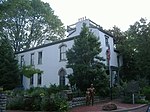Trinity Episcopal Church (Covington, Kentucky)

Trinity Episcopal Church is located in Covington, Kentucky, Madison Avenue. This historic church was founded November 24, 1842, in a third floor of a brick building near the Covington market. The cornerstone of the first church was June 24, 1843 and the first service was on June 30, 1844. The church has served the people of Covington and Cincinnati, Ohio through wars and floods. The church is active today, with a large congregation at its Fourth and Madison Avenue location. The Rev. Peter D'Angio is the rector. It is the second largest parish in the Episcopal Diocese of Lexington.Trinity Episcopal Church was placed on the National Register of Historic Places on March 1, 1982. This was because it is an excellent example of how medieval techniques in architectural design affected Episcopal church building in the United States in the 19th Century, in a style known as Gothic Revival.
Excerpt from the Wikipedia article Trinity Episcopal Church (Covington, Kentucky) (License: CC BY-SA 3.0, Authors, Images).Trinity Episcopal Church (Covington, Kentucky)
Electric Alley,
Geographical coordinates (GPS) Address External links Nearby Places Show on map
Geographical coordinates (GPS)
| Latitude | Longitude |
|---|---|
| N 39.0875 ° | E -84.510833333333 ° |
Address
Trinity Episcopal Church
Electric Alley
41011
Kentucky, United States
Open on Google Maps








